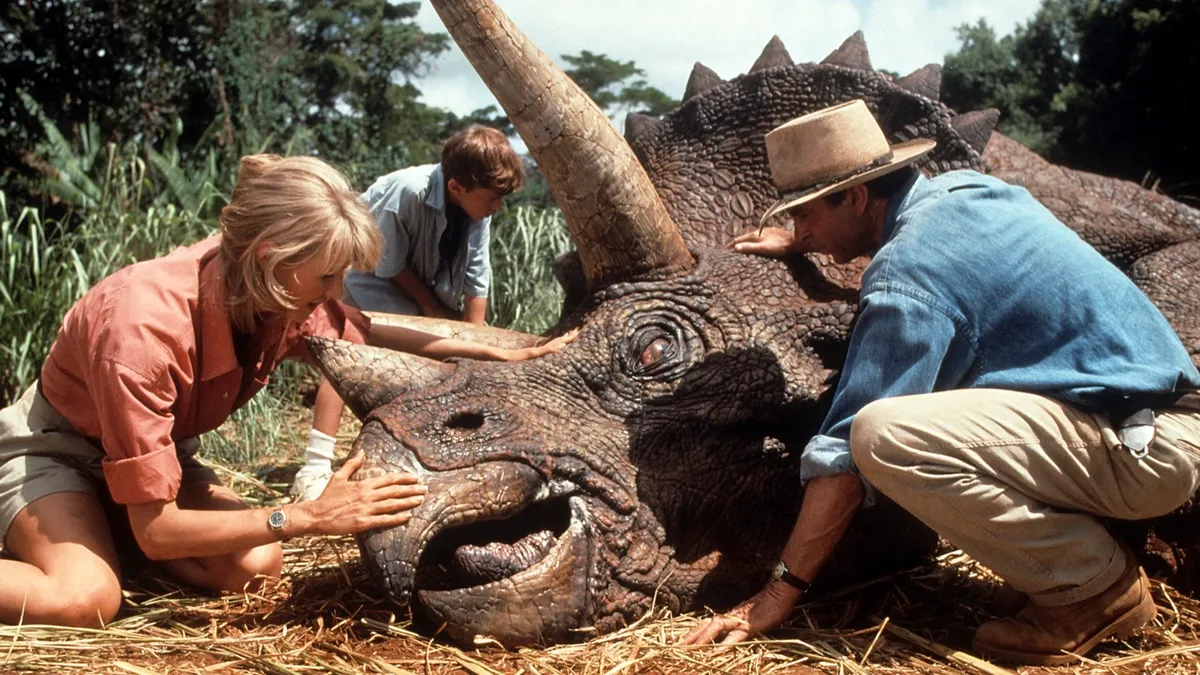Hard to believe but it has been 25 years since Jurassic Park first hit our cinema screens marks. When the film was released in the UK on 16 July 1993, it presented a new image of dinosaurs far different from the plodding dullards of old films and textbooks. Much of what we’ve learned over the past quarter of a century corroborates this image: dinosaurs were active, energetic and intelligent creatures that were closely related to birds.
But palaeontologists have learned a lot about dinosaurs over the last few decades, as a result of hundreds of new fossil species being discovered and the introduction of cutting-edge technologies like CT scanners and computer animation software. Here are five things that we now know were incorrect about the dinosaurs in Jurassic Park…
Dull skins
Jurassic Park (1993) - Welcome to Jurassic Park Scene (1/10) | Movieclips(YouTube/Movieclips)
Not only are the Jurassic Park dinosaurs scaly, but they are mostly drab in colour, with green, brown or earth-toned skin that also appears reptilian in style. Not all dinosaurs would have looked like this, however.
In the late 2000s, a graduate student called Jakob Vinther figured out how to tell the colour of dinosaurs. He found that if you put well-preserved feathers or skin under a scanning electron microscope, you can see pigment-bearing vessels called melanosomes. We know from modern animals that different-shaped melanosomes correspond to different colours: sausage-shaped ones make black, meatball-shaped ones a rusty red, and so on.
Through this technique, we now know that dinosaurs came in all sorts of fantastic colours, just like today’s birds. Some were black or white, others brown or ginger, some were multicoloured or iridescent, and one small carnivore called Sinosauropteryx even had a ringed tail of red and white bands.
Clones from fossils

The science of dinosaurs has progressed at an exponential pace over the last few decades, but there are still many things we don’t know. One of the great hopes of the Jurassic Parkera – and the premise of the entire movie franchise – was that dinosaurs could one day be cloned from fossilised remnants of their DNA.
Many palaeontologists have been looking, but as yet, not one fragment of the dinosaur genome has been recovered. And maybe it never will: DNA degrades quickly once an animal dies, so preserving even small amounts for millions of years may be purely in the realm of sci-fi.
Still, palaeontologist Dr Mary Schweitzer and her team have defied the odds and identified bits of dinosaur soft tissue like proteins and blood vessels, so maybe DNA is next…
Speedy T. rex
A famous scene in Jurassic Park shows a bloodthirsty T. rex chasing down a jeep moving at highway speeds. This was a reasonable assumption to make in 1993, as the long and muscular legs of T. rex looked like they were capable of great bursts of speed. Computer modelling studies, however, have revealed something quite different.
Work by Dr John Hutchinson in the early 2000s found that T. rex would have needed laughably huge leg muscles – making up an absurdly impractical 86 per cent of total body mass – to move at more than 32km/h (20mph). And then, even if this were somehow possible, the massive seven-tonne bulk of T. rex would have made it liable to tip over when running, like a truck taking a corner too quickly. The modern image of T. rex is an animal that probably maxed out at about 16-24km/h (10-15mph).
Lack of feathers

The scaly Jurassic Park dinosaurs look quite a bit like oversized lizards. This is how dinosaurs used to be depicted in children’s books and museum exhibits, and it was still the current thinking in 1993. But then, in 1996, everything changed.A farmer in Liaoning, China, discovered the skeleton of a dinosaur covered in feathers. Hundreds more soon followed.
These feathered dinosaurs showed once and for all that birds evolved from dinosaurs. It also proved that many dinosaurs had feathers, including small carnivores like Velociraptor, bigger meat-eaters like T. rex, and even some plant-eating dinosaurs.
A lot of palaeontologists now think that all dinosaurs had some type of feathers. Small, wispy ‘protofeathers’ (hair-like precursors of modern bird feathers) were added to some of the dinosaurs in some of the later Jurassic Park films, but in the most recent Jurassic Worldthe dinosaurs were scaly once again.
You’re safe if you’re still

There’s something else that Jurassic Park got wrong about T. rex. Recall the scene where the frightened youngster is told to stand still, because the T. rex is incapable of sensing prey that doesn’t move? New research shows that this advice would have proven deadly.
CT scans reveal that T. rex had a large brain, with huge olfactory lobes that powered a highly sensitive nose, and an inner ear with a long cochlea that could hear a wide range of sounds. Furthermore, the eyes of T. rex faced partially forward, permitting binocular vision with keen depth perception.
Add this all together and you get a smart animal with sharp senses that probably would have seen, smelled and heard the little boy. These superpowers were as much of a part of T. rex’s predatory arsenal as its claws and teeth.
This article first appeared inissue 323ofBBC Focusmagazine –check out the latest subscription deals here.
Follow Science Focus onTwitter,Facebook, Instagramand Flipboard
